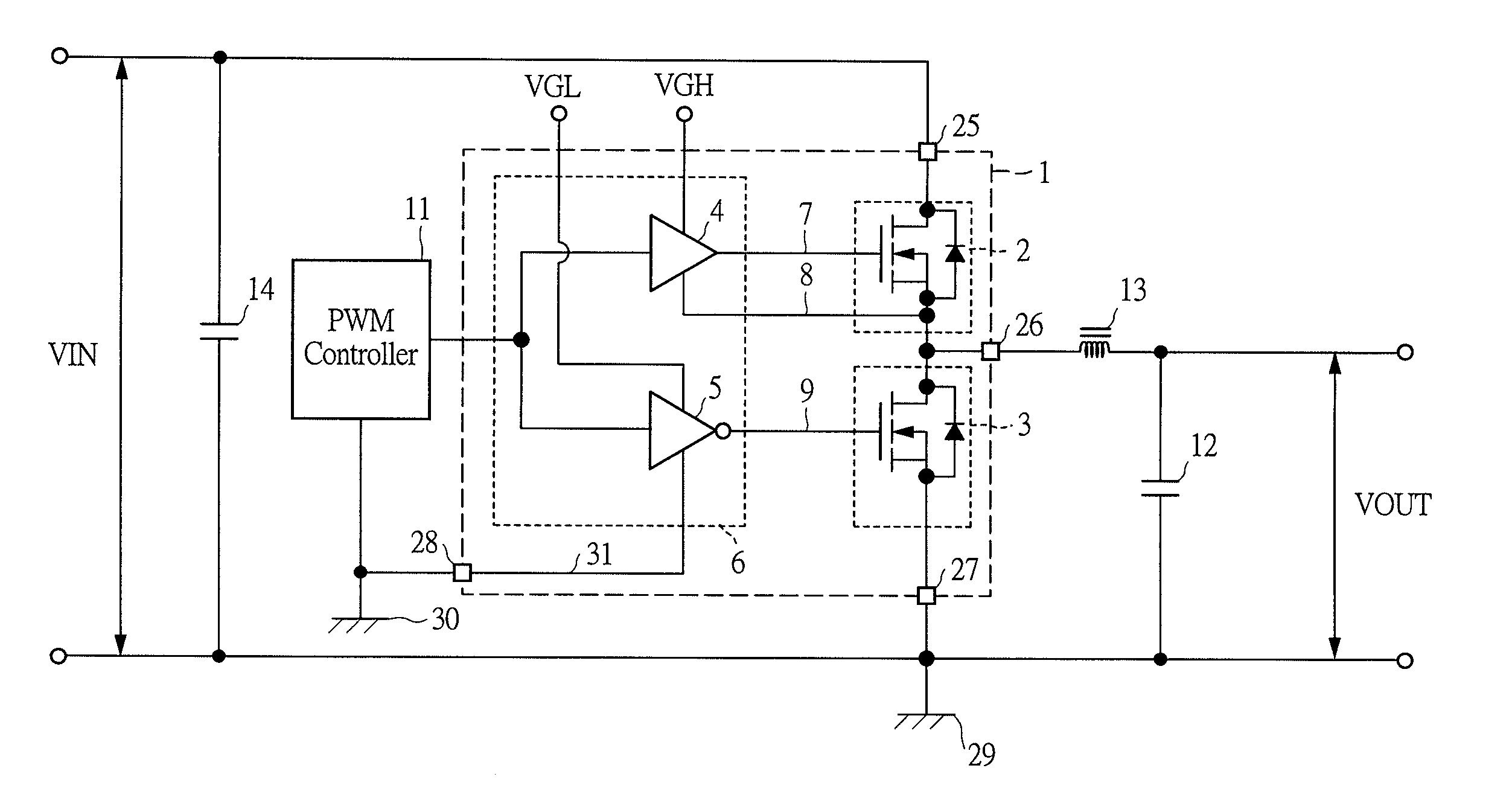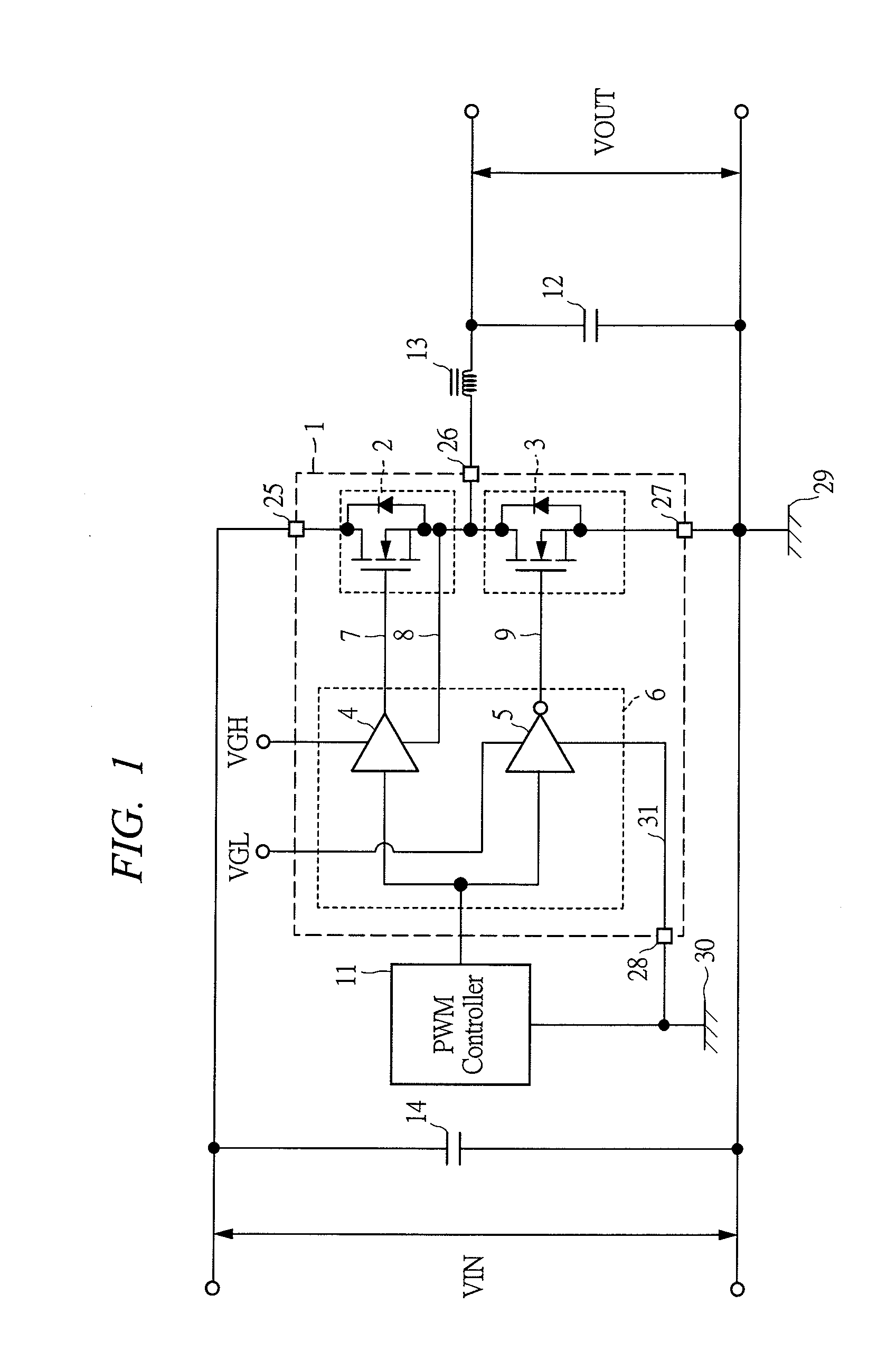Dc/dc converter
a converter and dc technology, applied in the direction of pulse technique, process and machine control, instruments, etc., can solve the problems of requiring a new drive system or a new member
- Summary
- Abstract
- Description
- Claims
- Application Information
AI Technical Summary
Benefits of technology
Problems solved by technology
Method used
Image
Examples
first embodiment
[0040]FIG. 1 is a circuit diagram showing a DC / DC converter using a system-in-package according to a first embodiment of the present invention. In a DC / DC converter according to the present embodiment, a system-in-package 1 comprises a high-side MOSFET (a high-side switch) 2, a low-side MOSFET (a low-side switch) 3, a high-side pre-driver 4 for driving a gate of the high-side MOSFET 2, and a low pre-driver 5 for driving a gate of the low-side MOSFET 3, where the pre-drivers 4 and 5 are formed as a driver IC 6 in one chip, and three chips of the high-side MOSFET 2, the low-side MOSFET 3, and the driver IC 6 are mounted in one package.
[0041]Since an operation principle and respective constituent elements of a DC / DC converter using the system-in-package 1 are similar to those of the conventional DC / DC converter shown in FIG. 10 described above, detailed description thereof is omitted here.
[0042]A feature of the DC / DC converter of the present embodiment lies in that a reference potentia...
second embodiment
[0049]FIG. 6 is a circuit diagram showing a DC / DC converter using a discrete device according to a second embodiment of the present invention. A feature of the second embodiment lies in that a reference voltage for a pre-driver 5 is taken from a portion nearest to a ground terminal of an input capacitor 14 through a wire 35. The second embodiment is a technique suitable for a DC / DC converter using the conventional discrete device instead of the system-in-package.
[0050]FIG. 7 is a diagram showing one example of a wiring pattern of a print circuit board using the discrete device according to the second embodiment, where the reference voltage for the pre-driver 5 is taken from a portion nearest to the ground terminal of the input capacitor 14 through the wire 35 in the wiring pattern on the print circuit board. Conventionally, as shown in FIG. 15, the reference potential is taken from a portion near to the source of the low-side MOSFET 3 through the wire 10.
[0051]In FIG. 7 and FIG. 15,...
third embodiment
[0053]FIG. 8 is a circuit diagram of a DC / DC converter in which an auxiliary Schottky barrier diode is built-in according to a third embodiment. A feature of the third embodiment lies in that a Schottky barrier diode (SBC) 36 is built-in between a gate and a source of a low-side MOSFET 3. In the present invention, since a gate voltage is changed to a negative potential only for a moment when self turn-on occurs and an output voltage of a pre-driver 5 is changed to a negative potential at this time, there is a possibility that a pn junction in a driver IC 6 operates so that the pre-driver 5 causes malfunction or breaking.
[0054]A feature of the third embodiment lies in that the gate voltage is clamped at −Vf which is a forward voltage of the auxiliary SBD 36 by incorporating the auxiliary SBD 36 between the gate and the source of the low-side MOSFET in order to prevent the above-described malfunction. Since the forward voltage of SBD is generally low relative to a forward voltage at t...
PUM
 Login to View More
Login to View More Abstract
Description
Claims
Application Information
 Login to View More
Login to View More - R&D
- Intellectual Property
- Life Sciences
- Materials
- Tech Scout
- Unparalleled Data Quality
- Higher Quality Content
- 60% Fewer Hallucinations
Browse by: Latest US Patents, China's latest patents, Technical Efficacy Thesaurus, Application Domain, Technology Topic, Popular Technical Reports.
© 2025 PatSnap. All rights reserved.Legal|Privacy policy|Modern Slavery Act Transparency Statement|Sitemap|About US| Contact US: help@patsnap.com



